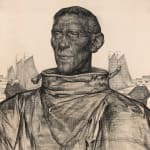 Sold to The Metropolitan Museum of Art, New York
Sold to The Metropolitan Museum of Art, New York
 Sold to The Metropolitan Museum of Art, New York
Sold to The Metropolitan Museum of Art, New York
Willem van den Berg (1886-1970)
Willem van den Berg was born on 16 February 1886 in The Hague, where he first trained with his father, Andries van den Berg, a painter, printmaker and art teacher. He later enrolled at the local Academie voor Beeldende Kunst and befriended the artist Willem van Konijnenburg (1868-1943) in 1913. Van den Berg also took study trips to Belgium, Italy and England and worked with the Barbizon artists in France and exhibited at the Jeu de Paume in Paris in 1926. In 1935, Van den Berg exhibited at the Art Institute of Chicago and continued to paint and exhibit internationally throughout his career. By 1938 he moved to Amsterdam, where he became the director of the National Academy of Fine Arts and remained there until his death on 23 December 1970.
Van den Berg dedicated his long, successful career to art of the realist tradition, specializing in portraits, animals, landscapes, and depictions of farmers and fishermen. The scenery in Scheveningen at the North Sea was his Brittany: frozen in time, untouched by modernity, these fishing communities with their hardworking modest inhabitants provided ideal inspiration. Rooted in the past by a refusal to don modern dress, the weathered worker is emblematic of a time that had all but vanished. His jagged face underlines the harshness and endurance needed for life upon the sea, the padded jacket protecting the protagonist in medieval garb.
Monumental drawings by Willem van den Berg are rare. A later large-scale drawing of Volendam Fisherman is now in the Minneapolis Institute of Art. The usual format would be smaller sketches of fisherman made in the port, to be worked in the studio into painted compositions. The small portrait of the Scheveningen fisherman—quickly rendered with colored washes—served as the source for a painting with the harbor in the background, now in the collection of Muzee Scheveningen.
Provenance
Private Collection, The Netherlands

